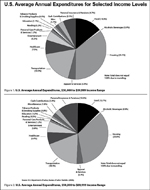Effects of Changes in Household Income on Household Spending
This article assumes that household incomes would be approximately at the median level through a period of unemployment. While this  simplifies the model considerably, it may not accurately portray what happens in reality. As an example of what might happen when a wage earner loses a job, we cite Table 2 of the 2008 Consumer Expenditure Survey (BLS, 2008).
simplifies the model considerably, it may not accurately portray what happens in reality. As an example of what might happen when a wage earner loses a job, we cite Table 2 of the 2008 Consumer Expenditure Survey (BLS, 2008). This table provides information about how much income is spent in various categories of goods and services based on pre-tax income. In several instances, average annual expenditures exceed average annual income before taxes; this could be due to missing values from income data. In other instances, some consumer units may be spending from savings or loans rather than wage income (BLS).
In this example, we will assume that prior to the layoff event the total pre-tax income is between $50,000 and $69,999. After the layoff event occurs total pre-tax income is assumed to be between $30,000 and $39,000 (see Figures 1 and 2). When the layoff event occurs in this example, total  food spending declines by 19.7% from $6,388 to $5,130 on an annual basis. In addition, food spending away from home declines by 28.1% from $2,626 to $1,887 on an annual basis. In the context of the IMPLAN model, this translates to less spending in grocery stores and restaurants, which further translates into lower employment in those establishments. Consequently, the establishments depending upon the spending of grocery store and food service workers also lose business. Other notable changes in spending include transportation (including new and used vehicles; -31.2%), entertainment (-36.1%), and housing (-26.5%). These results suggest that our IMPLAN UI impacts likely exceeds what happens in the real economy.
food spending declines by 19.7% from $6,388 to $5,130 on an annual basis. In addition, food spending away from home declines by 28.1% from $2,626 to $1,887 on an annual basis. In the context of the IMPLAN model, this translates to less spending in grocery stores and restaurants, which further translates into lower employment in those establishments. Consequently, the establishments depending upon the spending of grocery store and food service workers also lose business. Other notable changes in spending include transportation (including new and used vehicles; -31.2%), entertainment (-36.1%), and housing (-26.5%). These results suggest that our IMPLAN UI impacts likely exceeds what happens in the real economy.
References
U.S. Department of Labor, Bureau of Labor Statistics. Consumer Expenditure Survey Frequently Asked Questions. Retrieved August 30, 2010, from http://www.bls.gov/cex/csxfaqs.htm#q20
U.S. Department of Labor, Bureau of Labor Statistics. (2009). Income before taxes: Average annual expenditures and characteristics, Consumer Expenditure Survey. (2009). Retrieved August 25, 2010, from http://www.bls.gov/cex/2008/Standard/income.pdf
